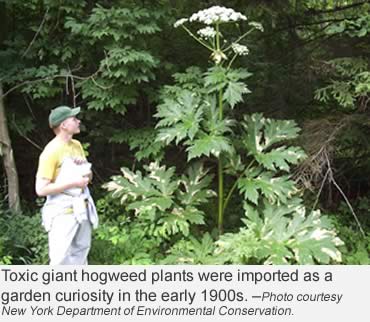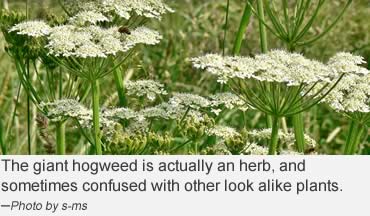Photo: UV-light exposure on skin touched by giant hogweed sap creates extremely painful blisters.
It’s King Kong of monster plants, and it might be growing in the woods near you. From a distance, it looks pretty—like a spectacular, gigantic relative of Queen Anne’s Lace. But giant hogweed is one of the most toxic plants you could ever encounter.
Be aware and beware. And DO NOT touch it.
It stands out because it grows so tall, so quickly. It’s between 14- and 20-feet tall, its leaves spread 5- to 6-feet wide and its flowerheads are 2- to 2 1/2-feet in diameter.
It looks innocent, but it’s not. Touching a giant hogweed plant can cause severe burns, blisters, scarring and blindness if it touches the eye.
 The toxic sap found in the leaves, stems, flowers and roots creates extremely painful blisters when it touches skin exposed to UV light from the sun.
The toxic sap found in the leaves, stems, flowers and roots creates extremely painful blisters when it touches skin exposed to UV light from the sun.
In June 2018, a Virginia college student chopped down a giant hogweed plant while working a summer job with a landscaping crew. The toxic sap had touched his face, and by the time he returned home to shower, he had second- and third-degree burns from sun exposure where the plant touched his skin.
The burns were so severe, he spent two days in the hospital and was advised to avoid sun-exposure for the following six months.
If a giant hogweed (Heracleum mantegazzianum) is not growing in woods near you now, that’s wonderful. But, from the time it was introduced to North America in the early 1900s as a garden curiosity because of its extremely large size and impressive flowers, the invasive’ s foothold has spread.
Like all invasive plants, it spreads at a steady, unchecked pace.
 Giant hogweed can now be found in all Canadian provinces, the Pacific northwest, in Northeastern seaboard states, with new growth now found in Virginia and North Carolina, as well as Midwestern states. The USDA classifies it as a noxious invasive weed.
Giant hogweed can now be found in all Canadian provinces, the Pacific northwest, in Northeastern seaboard states, with new growth now found in Virginia and North Carolina, as well as Midwestern states. The USDA classifies it as a noxious invasive weed.
It grows vigorously in the early season, tolerates full shade and flooding, and quickly dominates stream banks and ravines, crowding out native plants.
If you think you’ve spotted one, don’t touch it. Several other plants—wild parsnip, cow parsnip, Angelica—have similar appearances and contact with them may also cause burns.
This summer, in New York, there’s a strong, continued effort to deal with giant hogweed. The Department of Environmental Conservation is asking anyone who locates a plant to stay away from it, and to report the sighting to the Division of Lands and Forests.
The department advises anyone who sees what may be a giant hogweed to take photos of the plant (stem, leaves, flower, seeds) and note location information before emailing the information to ghogweed@dec.ny.gov. Residents can also call (845)256-3111 to report a sighting.
 With landowner permission, New York’s Giant Hogweed Control Program will manage confirmed hogweed infestations for free by cutting the roots, using herbicide, or removing flower heads and properly disposing of the growth, most of which cannot be composted.
With landowner permission, New York’s Giant Hogweed Control Program will manage confirmed hogweed infestations for free by cutting the roots, using herbicide, or removing flower heads and properly disposing of the growth, most of which cannot be composted.
You can learn more about giant hogweed, including identification tips and common lookalike plants here.
No matter where you live, any state department of conservation or natural resources can provide early detection assistance if you think you may have spotted this scary and invasive plant.
—Resources: New York Department of Environmental Conservation, US Department of Agriculture, Invasive Species Council of BC; Businessinsider.com, July 2018.